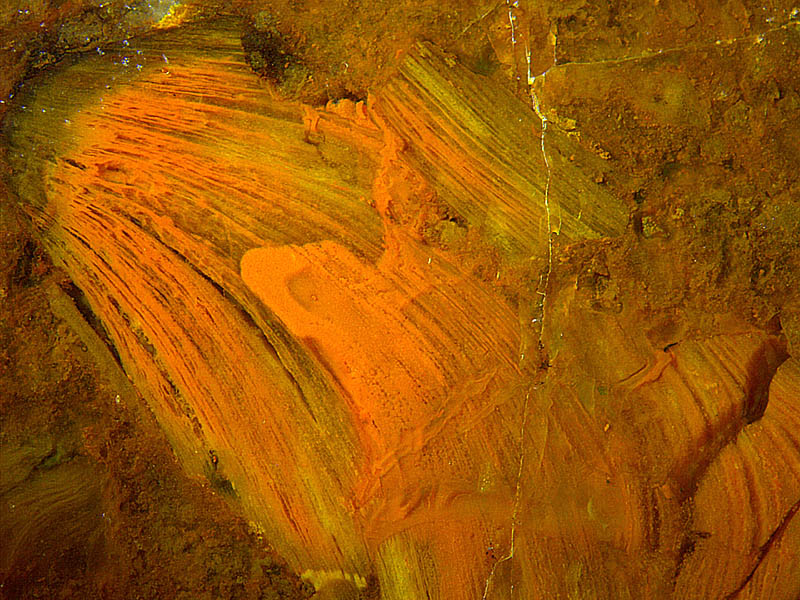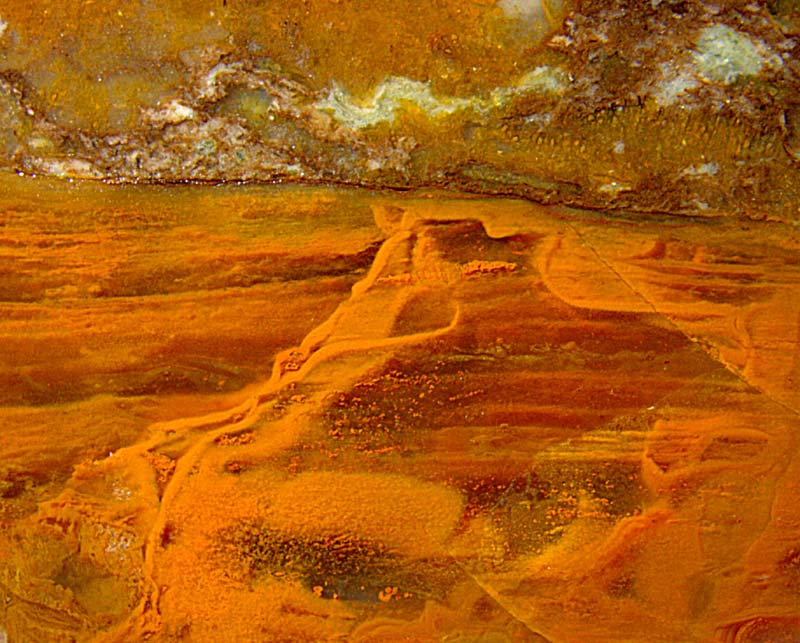Eerie shapes athwart microbial layer
stacks (6)
 Although
the fossil shapes called "eerie" here are not a well-defined group, it
is tried here to set them apart from the more conventional shapes
encountered in cherts.
Although
the fossil shapes called "eerie" here are not a well-defined group, it
is tried here to set them apart from the more conventional shapes
encountered in cherts.
The shapes considered here
- are of various appearance: red-stained bulky
clouds, thin red sheets,
or
anything in between,
- had formed later than the conventional
shapes in cherts,
- had formed mostly (but not always)
in disregard of pre-existing
structures,
Fig.1: Red chert (Permian) with
features resulting from quite different processes: red
cloud penetrating
thin sheets from microbial layer growth, large early cracks in the
layer stack below right.
Like
the conspicuous red shapes considered before (
Permian
Chert News 18, 27,
28,
36, 37
), the one in Fig.1
is enigmatic since it does not indicate a
possible interpretation. Its outline is partially well-defined and
smooth but fuzzy elsewhere. One part of the boundary on the left fits
well to the stack of layers as if one of the layers or the
space between them had acted as a diffusion barrier against the
spreading red stain. An outgrowth emerging upwards from the big
red shape might be analogous to a
lateral outgrowth from a red front in
27 (there below in Fig.2).
This possible analogy, however, does not provide an explanation for the
spreading red stain.
Likewise unexplained
remain the rug-like
formations, seen in Fig.2 mostly as narrow sections. Possibly, some dissolved iron compound was guided by means unknown along curved sheets, oxidized, and precipitated as fine-particle hematite which makes a strong red colour even with tiny volume fraction. Since
diffusion alone
would make diffuse outlines, the sharp outlines seen here must
be due to a quite
different process which has not revealed itself.

Fig.2: Red chert (Permian) with a stack of stained microbial sheets traversed by
apparently immaterial
rug-like formations,
(Image width 7mm, same scale as Fig.1.)
Apparently the formation of the red rugs was neither
affected by pre-existing
structures nor by mutual contact.
Either picture shows very narrow brittle cracks as late formations in the hard chert. Something else in
Fig.1 is quite different. The stack of microbial layers had been
fractured well before final silicification, as seen from the curvature
of the layers in the fragment which must have been turned upside down.
Obviously, the red outgrowth of the cloud grew later.
Other evidence of
fracture at an early stage of silicification is provided by the wide
cracks below right in Fig.1. By comparing the layer pattern on either
side of the crack, the expected lateral displacement becomes evident.
The absence of displacements on either side of large red stripes as
in 36 shows that there were no wide cracks involved.
This contribution continues the series of eerie shapes without getting closer to an explanation.
Samples: H/375.1 (1999)
and H3/102 (1995),
old
fragments of a Lower Permian
chert layer,
found among
glacial river deposits at Hänichen,
Döhlen basin, Freital near Dresden,
Saxony.
H.-J.
Weiss 2022
|
 |
 38 38 |

 38
38 Although
the fossil shapes called "eerie" here are not a well-defined group, it
is tried here to set them apart from the more conventional shapes
encountered in cherts.
Although
the fossil shapes called "eerie" here are not a well-defined group, it
is tried here to set them apart from the more conventional shapes
encountered in cherts. 

 38
38